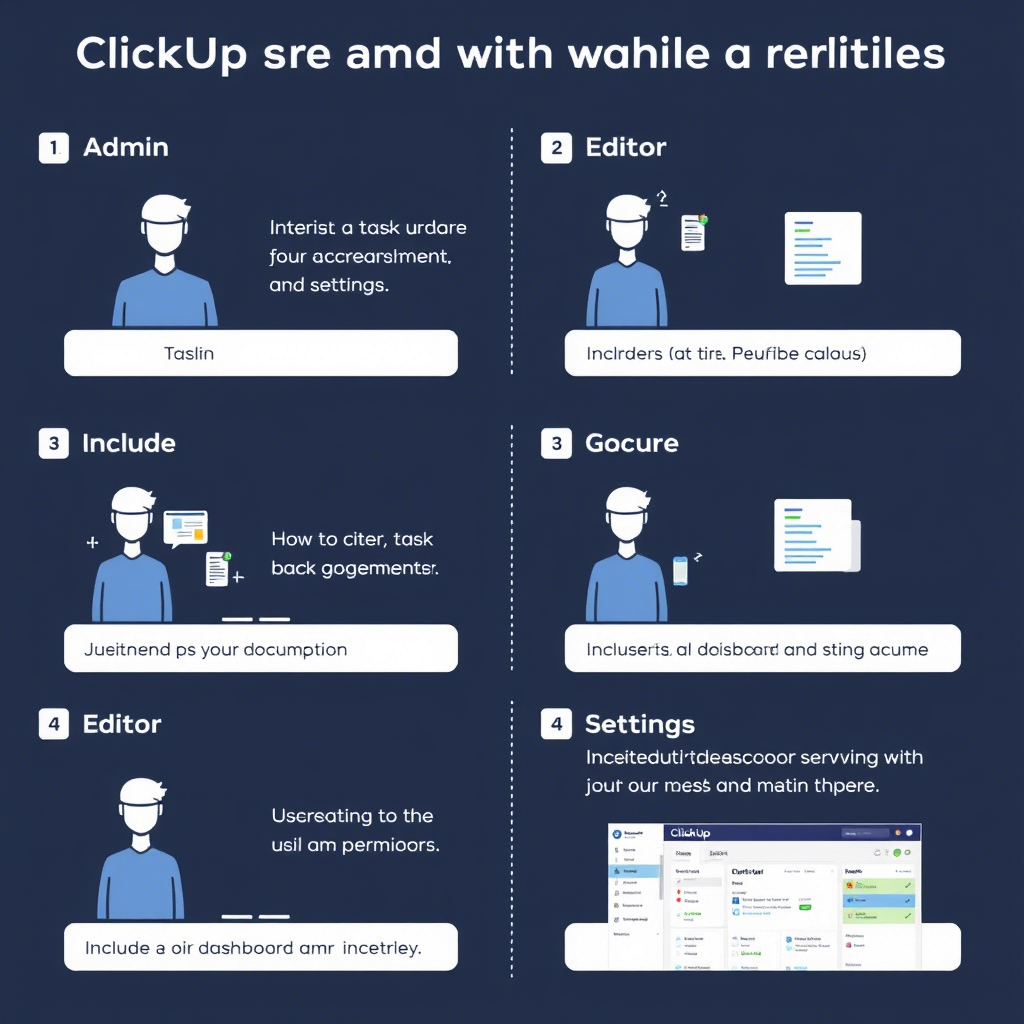Managing a team’s workflow and ensuring everyone has the right level of access to the tasks and information they need is a big part of effective project management. If you’re using ClickUp, a powerful tool for task management and team collaboration, understanding its permissions and roles is crucial. Knowing who can do what and setting up the right permissions for your team helps improve productivity, maintain data security, and keep your projects running smoothly.
In this guide, we’ll walk you through ClickUp’s permissions and roles, how they work, and how to manage team access like a pro. By the end, you’ll have a clear understanding of how to set up and manage user roles in ClickUp to fit your team’s needs.
1. Understanding ClickUp’s Hierarchy and Structure
Before diving into roles and permissions, it’s essential to understand how ClickUp is structured. ClickUp uses a multi-level hierarchy that includes:
- Workspace: The top level that includes all of your projects and teams.
- Spaces: These are areas within your workspace dedicated to specific departments or projects.
- Folders: Folders help organize projects and tasks within spaces.
- Lists: Lists hold your individual tasks and to-do items.
- Tasks: The actual work items that your team will complete.
Each of these levels allows you to control who can access and make changes, ensuring the right people have the correct permissions.
2. ClickUp Roles and Their Access
ClickUp has several predefined roles, each with different levels of access. Let’s break down these roles and explain what each one can do.
Owner
The Owner is the top-level role. The Owner has full control over the entire workspace, including:
- Billing and subscription settings.
- Managing users and permissions.
- Controlling integrations and workspace settings.
This role is usually assigned to the person who owns or is responsible for managing the ClickUp account.
Admin
Admins have almost the same access as the Owner but don’t manage billing. They can:
- Manage user permissions.
- Edit workspace settings.
- Create or delete spaces and folders.
Admins are often team leads or project managers who need high-level access but don’t need to handle billing.
Member
Members are the regular users of ClickUp. They have access to spaces, folders, and tasks, based on the permissions granted to them. Members can:
- Create, edit, and complete tasks within assigned spaces and lists.
- View and comment on tasks.
Members can’t manage settings or adjust permissions but are the core users who do the work.
Guest
Guests are people who need limited access to your ClickUp workspace. These could be:
- Clients.
- Freelancers.
- Contractors.
Guests typically only have access to specific tasks, lists, or spaces shared with them, and they cannot make changes to the workspace or access other areas.
Custom Roles (Available on Business+ and Enterprise Plans)
For teams that need more specific control over user permissions, ClickUp allows you to create Custom Roles. This option is perfect if your team has unique needs that don’t fit into the default roles. You can:
- Assign permissions to each role for tasks, lists, folders, and spaces.
- Customize what each role can see and do within ClickUp.
Custom roles are perfect for teams with complex workflows, allowing you to tailor permissions precisely to your team’s requirements.
3. How to Set Up Permissions for Different Roles
Workspace Permissions
Workspace permissions allow you to control who has access to the entire workspace and its settings. You can choose whether a person can manage users, change workspace settings, or simply access and complete tasks. This permission is typically given to Owners and Admins.
Space and Folder Permissions
ClickUp allows you to manage access at the space and folder level, which is useful if different teams or projects require different access levels. For example:
- A marketing team may need access to all marketing-related folders, but a development team may only need access to their own project spaces.
- You can assign different permissions for creating, editing, and deleting tasks or folders within each space.
Task-Level Permissions
Task-level permissions are crucial for ensuring only the right team members can edit, comment, or delete tasks. You can assign task permissions based on:
- Assigned Users: These are the people who are working on a task.
- Task Viewers: These users can view the task but cannot edit it.
- Task Commenters: These users can leave comments but cannot edit the task.
4. Best Practices for Managing Team Access
1. Start with Clear Role Definitions
Before assigning permissions, define clear roles for your team. For example, decide who will be Owners, Admins, and Members. This helps prevent confusion later on and ensures everyone knows their responsibilities within the platform.
2. Limit Guest Access
When adding guests (like clients or external collaborators), it’s essential to limit their access to only what’s necessary. This reduces the risk of exposing sensitive information or accidental changes to important tasks.
3. Regularly Review Permissions
As teams grow and projects evolve, it’s important to review permissions regularly. Check if any team members need more or fewer permissions, especially as new members join or roles shift. Keeping your permissions updated ensures that everyone has the right level of access at all times.
4. Use Custom Roles for Complex Needs
If your team needs more flexibility than what the default roles offer, consider using Custom Roles. This feature allows you to tailor the permissions specifically to your workflow and business needs, ensuring that everyone has access to the tools they need to succeed.
5. Provide Training for Your Team
Ensure your team understands the importance of permissions and how to use ClickUp’s features properly. When team members are trained to use ClickUp effectively, it minimizes mistakes and helps them work more efficiently.
5. How Certified ClickUp Consultants Can Help
Managing ClickUp roles and permissions can be overwhelming for some teams, especially if you’re just getting started. If you want expert guidance or assistance in setting up your ClickUp workspace, Certified ClickUp Consultants can help you optimize your account settings, permissions, and workflows. They can provide tailored solutions to fit your team’s needs and help streamline your processes.
For more information on how ClickUp consultants can assist you, visit their official website or reach out to a consultant for personalized help.
6. Avoid Common Mistakes When Managing ClickUp Permissions
While managing ClickUp permissions can greatly enhance your workflow, there are some common mistakes to watch out for:
- Giving too much access: Avoid giving roles more access than necessary. For example, don’t give Member-level access to tasks or folders they don’t need.
- Not updating permissions: As team structures change, it’s easy to forget to update permissions. Make sure you regularly review and adjust permissions.
- Failing to train users: If your team doesn’t know how to use ClickUp correctly, they may misuse their permissions, causing confusion or errors.
Conclusion
Managing team access in ClickUp is essential for maintaining a secure, efficient, and organized workspace. By understanding ClickUp’s roles and permissions, you can ensure that each team member has the appropriate level of access for their role. Whether you’re working with a small team or managing a large project, setting up the right permissions will help your team collaborate better and get more done.













Leave a Reply